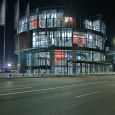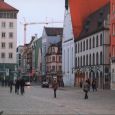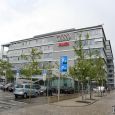Ingolstadt
Advertisement
By Air
Originally only used by the military airfield Ingolstadt-Manching, the last few years, mainly by local companies Audi and EADS also served civilian, is located 8 kilometers from the city limits on the B 16 The closest airport for international scheduled traffic is the 70 kilometers to Munich Franz Josef Strauss in Erding.
By Train
To the railway network is connected with the Ingolstadt Hauptbahnhof Ingolstadt and Ingolstadt Nord train station for passengers and for freight marshalling yards with three.Ingolstadt-distance transport is the high-speed line between Nuremberg-Ingolstadt-Munich every two hours of high-speed trains of the relationship Munich - approached Hanover-Hamburg / Bremen - Nuremberg - Berlin - Hamburg and Munich-Nuremberg-Kassel. In Section Nuremberg-Ingolstadt-Munich, this overlap to a hour. In addition, keep in rush hour ICE trains from Munich-Nuremberg-Frankfurt / M. - Cologne (- Dortmund), which together with the other ICE trains in the morning and evening hours, half an hour. In addition, there is a Berlin to Moscow.Regional services run on weekdays, hourly regional trains to Munich, Treuchtlingen, Donauworth / Ulm, Regensburg and Augsburg.On weekends and public holidays the train to Regensburg and Donauworth only run every two hours. In addition, trains run every two hours of the Munich-Nuremberg-Express, and the additional rush hour trains between Munich and Ingolstadt.
By Bus
The public transportation in Ingolstadt goes back to the establishment of a horse track, which was operated between 1878 and the city center. This was replaced by buses in 1921, where plans were rejected for the construction of a tramway network until the 1960s. Since 1988, the public transportation in Ingolstadt will be conducted by the Ingolstadt-based transport company (INVG), which operates 44 bus routes with a total route length of 653 km.
By Road
The most significant road access from Ingolstadt is the six-lane motorway 9 (A 9). The city is at these junctions by the Ingolstadt South (formerly known as "Auwaldsee") and Ingolstadt North / East (earlier signs "interchange IN-North") is connected. In addition, several major roads run through the city of Ingolstadt. B 16a, which connects with Ingolstadt Vohburg crosses the A9 motorway in the north junction Ingolstadt / Ingolstadt East (former markings: Cross Ingolstadt-Nord) and ends in Ingolstadt.In this urban area is expanded to four lanes throughout. Like the B 16a, B 16 crosses the city in the east-west direction. It is a major link road to Donauwörth and Regensburg. From north to south, runs mainly in the city four-lane B 13, which connects with Eichstätt Ingolstadt, Pfaffenhofen, respectively.
By Ferry
Over many centuries, the Danube in Ingolstadt, a key transport route.With the opening of Donautalbahn but decreased the importance of shipping for the 1874 town and led to the complete setting of the Danube Steam Navigation in Ingolstadt. Nevertheless, there were still up in the 1950s excursion ships arriving in Ingolstadt at irregular intervals.The former system was in the harbor area of the city theater.During the Second World War, many warships, including six submarines, Type II, transported by heavy haulage on the highway to Ingolstadt in the area of today Schiller bridge lowered into the water and transferred into the Black Sea.Today the Danube at Ingolstadt with a national waterway and motorized vehicles to be used only with special permission.
Theater Ingolstadt
is the playhouse of the city Ingolstadt.The first theater was built in 1873 on the south side of Gouvernementsplatzes (now Town Square), the architect was Joseph Hansel Maier.The building was rebuilt from 1929 to 1930 and the Second World War on 9 April 1945 destroyed.In the postwar period was a makeshift room in an inn (Rappensberger basement, street food) set up the first performance was on 20 February 1946. In 1959 the competition was announced for a new theater, the design contract, the architects were Mr. Walt Hardt Hamer Hamer and Marie-Brigitte office. Groundbreaking was in December 1962, the civil works started on 18 April 1963, the topping-out ceremony on 30 November 1964 celebrated.The building was on 21 January 1966 opened with a ceremony, was the first performance of Mozart 's opera The Marriage of Figaro, a guest performance by the Bavarian State Opera in Munich.The polygonal concrete building, whose design language, both the medieval urban structure and the neoclassical fortress architecture accommodates, was honored in 1967 with the first in the BDA Bayern, a model was the German Pavilion at the World Exhibition in Montreal - show (April 28, 27 October 1967) .In addition to venues in the theater building a ballroom for up to 1,300 visitors, a restaurant and exhibition rooms are located.
Bavarian Army Museum
is one of the military history of dedicated state Bavarian museum, which today in Ingolstadt is located. By 1945 it had its headquarters at the site of today's Bavarian State Chancellery in Munich.The museum was founded by King Ludwig II at the suggestion of General Friedrich von Bothmer , and the War Minister Joseph Maximilian of Maillinger founded in 1879. It should summarize the scattered in collections all over Bavaria. Until 1905 it was in Munich in the Bavarian army arsenal and then moved into a five-year construction period, designed by Louis Mellinger on newly built monumental courtyard around in Munich was at this point before the barracks courtyard stood.On 1 February 2010 Ansgar tear came to the new post as director of the museum. Within a short time he worked out a reorganization of the museum, which is particularly manifest in the special exhibitions. Military-historical themes were often previously isolated in defense technology known or uniform perspective has shown, it is now Military History in the socio-historical context made tangible. After an exhibition on African-American U.S. soldiers in the occupation in 2011 hosted the traveling exhibition of the " Foundation for the Memorial to the Murdered Jews of Europe "about Nazi military justice.
German Medical History Museum
The museum is housed since 1973 in the old anatomy in Ingolstadt. This late baroque palace in the years 1723 to 1736, designed by Gabriel de Gabrieli built by the medical faculty of the former Bavarian state university and used until 1800 as a University Institute. After the university in Landshut was moved, the building served, to which one belongs Medizinalgarten, as a farm, before it was fed to its present use. The building is worth seeing especially the anatomy hall with its former baroque ceiling fresco.The permanent exhibition is divided into three sections: The first floor of the "Old Anatomy" is the early modern medicine and its origins in the Greco-Roman antiquity, dedicated. The upper floor uses around 1830 and shows the differentiation of scientific medicine on the example of operational disciplines and medical diagnostics . Opened in September 2008 the Department of Medical presented in a building at the end of the medicinal plants garden, under the theme "Healing with laser and shock wave "a selection of the extensive medical collection of the museum. The special collections include, among other things, graphics (about 2,500 doctors portraits), collection of Thilo von Haugwitz (ophthalmology), Harald Feldmann (ear, nose and throat medicine) and clinical chemistry.for visitors is by appointment the opportunity to use the graphical collection, the library and special collections for ophthalmology, ear, nose and throat medicine, clinical chemistry, electrical therapy and obstetrics.
Mobile Museum
is a museum of Audi AG in Ingolstadt , which deals with the history of the company and its predecessor companies.In the 23 meters high round glass and steel building that is part of the Audi Forum Ingolstadt, are on a total of about 6000 square meters, about 50 cars and 30 motorcycles and bicycles as well as many other exhibits on the brands Audi, DKW, Horch, Wanderer and NSU issued.The building was designed by Gunter Henn.A special feature in 2000, finished glass rotunda is a paternoster with 14 prototypes from 100 years of automotive history.
Klenze park
is one of about 20 ha large park in Ingolstadt.It is bordered by the Danube, west and south by the bridge-head / Stauffenbergstrabe and the east by the railway-Ingolstadt Nuremberg limited.The Klenzepark is - separated by the Danube - across from the Ingolstadt- old in the subdistrict head bridge.In the warm season, about 100,000 visitors per month use the Klenzepark, mostly teenagers.While about 75% of park visitors come from Ingolstadt and the surrounding area, the remaining approximately 25% of targeted travel from distant places.The park was established in 1992 at the Bavarian horticultural show and created by the royal court architect Leo von Klenze named. Klenze was instrumental in building the Bavarian fortress of Ingolstadt country involved and in particular, designed the facades of buildings in today's Klenzepark.Before 1992, the area offered a bleak picture, it was used as an industrial warehouse area and the buildings were falling apart.The park is now home to the Reduit Tilly and the tower Triva two fortresses, the museum's purposes were fed.They are home to the Bavarian Army Museum and the Museum Bavarian police.
Bavarian Police Museum
is the central museum for the Bavarian police.It should, according to the Bavarian State Ministry of the Interior in late 2008 in Ingolstadt own premises in the historic tower Triva in Klenzepark receive.In February 2011 an opening in the same year was announced.It is to include thousands of exhibits, ranging back to 1812.The museum documents the history, organization and development of police in Bavaria since 1946.It is under the supervision of the Presidium of the Bavarian riot police (BPP).The first special exhibition at the Bavarian Police Museum - "60 years of police in Bavaria" - took place from 26 September 2006 until 23 September 2007 in the offices of the Bavarian Army Museum in Ingolstadt in the Reduit Tilly instead, have been shown to photographs, documents, uniforms, insignia, equipment vehicles and armaments of the Bavarian State Police and other police forces in Bavaria.End of 2006, 9466 people visited the exhibition.
Information not available






